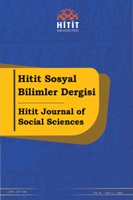Tarihî metinlerde önvarsayımın görünümü: Kül Tigin yazıtı
The Appearance of Presupposition in Historical Texts: Köl Tigin Inscription
Author(s): Seçil HirikSubject(s): Lexis, Semantics, Historical Linguistics
Published by: Hitit Üniversitesi
Keywords: Presupposition; Types of Presupposition; Presupposition Triggers; Orkhon Turkic; Köl Tigin Inscriptions;
Summary/Abstract: Presupposition, which can be considered as one of the elements of implicit structure, is a concept that describes the hidden pieces of information that the speaker conveys to the interlocutor in his/her utterance. Presuppositions are the semantic background which the speaker shows with limited units in the surface structure but which has a counterpart in the deep structure. In order for presuppositions, which are also explained by the difference between what is said and what is communicated, to be meaningful, the context between the speaker and the addressee and the past experiences, experiences, common knowledge, etc. shapiŋ the context must be common. Presuppositions, which can be listed as being negated, carrying certainty, having a relation of entailment, presenting a surface appearance, being non-focal, are divided into different categories according to their ability to be marked with different types of linguistic markers in the word. The corpus of this study consists of Köl Tigin Inscription (KT), one of the Köktürk texts. In this analysis, which aims to reveal the types of presuppositions and the appearance of presupposition indicators in a historical text, presuppositions were evaluated according to the categories of existential presupposition, factual presupposition, lexical presupposition, structural presupposition, nonfactual presupposition, counterfactual presupposition and inferential presupposition. The presuppositions determined by these seven categories in Köl Tigin are further classified according to their coding with morphological, lexical and syntactic markers. Thus, it is aimed to have an idea about the status and usage of presupposition types and demonstrators in Orkhun Turkic, one of the historical dialects of Turkish, through a specific text and to serve as a source for similar studies.
Journal: Hitit Sosyal Bilimler Dergisi
- Issue Year: 16/2023
- Issue No: 2
- Page Range: 350-365
- Page Count: 16
- Language: Turkish

